How Many Coins Are In A Coin Roll? (Chart & Story)
This article will tell you everything you need to know about coin rolls, sometimes referred to as bank rolls or coin wrappers.
Check out the chart below for a quick answer. Read on for more information about coin rolls in the United States, Canada, Europe, and the U.K.
How Many Coins Are In a Coin Roll? (Chart)
You’ve probably seen a cashier break open a roll of coins when they run out of change. Have you ever wondered how many coins are in a coin roll? That depends on the type of coin.
| Pennies (one cent) | 50 | 125 grams | 50¢ | Red |
| Nickels (five cents) | 40 | 200 grams | $2 | Blue |
| Dimes (ten cents) | 50 | 113.5 grams | $5 | Green |
| Quarters (25 cents) | 40 | 226.8 grams | $10 | Orange |
| Half Dollars (50 cents) | 20 | 226.8 grams | $10 | Tan |
| Dollar coins ($1) | 25 | 202.5 grams | $25 | Black |
The weights provided in the chart don't include the paper of the roll itself, which is largely negligible. Knowing how much a roll of coins weighs may help you plan out a trip to the bank if large quantities of coins need to be transported.
What Is a Coin Roll? Background and Uses
Coin rolls are also called coin wrappers. They are color-coded to standards set by the American Bankers Association. Red wrappers for pennies, blue wrappers for nickels, green for dimes, and orange for quarters.

Various bank rolls of coins
Coin wrappers used to have solid colors, but machine-wrapped coin rolls today are made from white or Buff Kraft paper, with writing and end stripes of the appropriate color.
Half dollar coin wrappers are tan, and small dollar coins like the Sacagwea and Presidential dollars have gray wrappers, but these two coins are seldom seen. Kennedy half dollars are too big and bulky, and dollar coins have never caught on with the public.
Bank tellers and cashiers dislike them even more. Modern bank drawers have no space for either half dollars or dollar coins, forcing them to be crammed into the spot where coin rolls go, or dumped in one of the paper money sections.
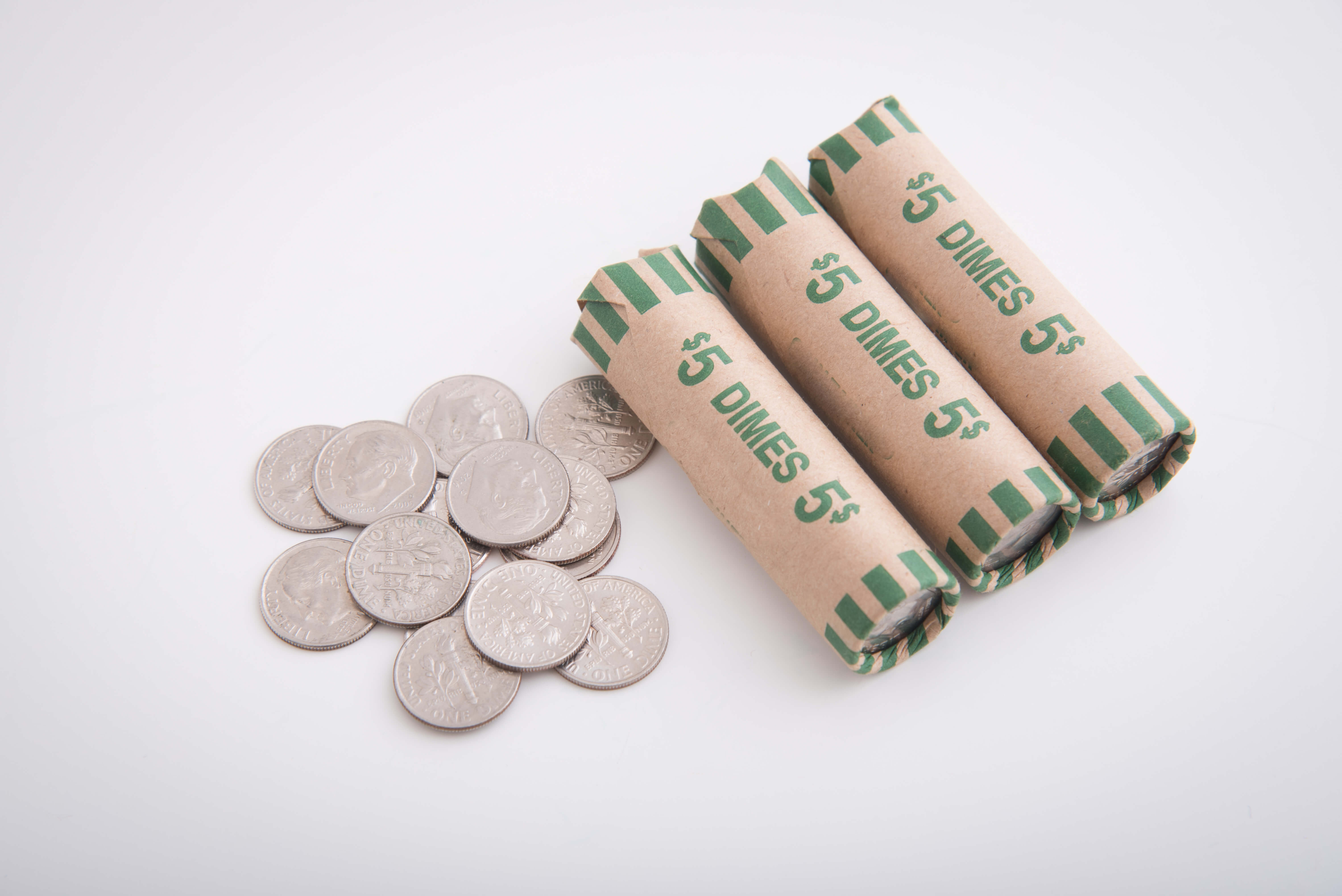
Image via Shutterstock
Professional coin rolling operations are moving away from 1,000-foot rolls of coin wrapper paper for the coin counters, to using a heavy, clear shrink-wrap plastic. This simplifies logistics, and makes coin rolls that won’t split open if you drop them. It also allows retailers to check for any slugs or incorrect coins before splitting open the roll.
What to Know About Taking Your Coin Rolls To The Bank
Many banks and businesses refuse to take wrapped coins for deposit or purchases. A common fraud is to fill paper coin rolls with washers or slugs and cash them in. Another scam involves putting one or two fewer coins in a roll.
Some bank branches have large coin counting machines in the lobby that are free for customer use, but other banks will simply turn people away rather than pay for a teller to unwrap, count and rewrap coin rolls. The only option for these people is to pay to use the CoinStar machine at the local Walmart or grocery store.
How Many Coins Are In Coin Roll Bank Boxes?
![coin rolls boxes[1]](https://cdn-img.gainesvillecoins.com/blog/2022/04/coin-rolls-boxes[1].jpg)
PM Company coin roll bank boxes. Each box holds 50 rolls.
Companies order rolls of coins from their bank. Banks in turn receive their coin orders from the Federal Reserve packed in “bank boxes” of 50 coin rolls each. These are delivered by armored car from companies such as Brinks that have a contract to transport coins to where they are needed.
Bank coin boxes are color-coded to match the coin rolls of each denomination. Not shown above are the $500 half dollar coin roll bank box (brown writing), and the $1,250 dollar coin bank box (black writing). Bank boxes of coins have the denomination and total face value printed on the ends to make taking inventory easy.
US Mint Ballistic Bulk Coin Bags
![bulk coin bags table[1]](https://cdn-img.gainesvillecoins.com/blog/2022/04/bulk-coin-bags-table[1].png)
The Federal Reserve banks order coins from the US Mint in bulk coin bags made of ballistic cloth. Each US Mint bulk bag holds hundreds of thousands of coins, and is strapped to heavy steel pallets. Together, a full bag and pallet weigh over a ton.

Image via US Mint
A Mint bulk bag of Lincoln cents contains 400,000 pennies, at a total face value of $4,000. The bulk bag for quarters holds 200,000 coins, with a total face value of $50,000.
Coin Rolls In Other Countries
These color codes for coin rolls only apply to US banks. Each nation has its own color codes. The European Union has moved from paper coin wrappers to reusable hard plastic coin rolls.
Others, like the United Kingdom, don’t use coin rolls at all. They use small plastic bags that can be used for different denominations of coins, with check boxes to mark what’s inside—one denomination per bag, please.
Coin Rolls In Canada
The size of the Canadian nickel, dime, and quarter are close to those of the US, at least in diameter. This is because most vending machines in Canada are manufactured in the US, and the coin acceptors are built for American coins.
This coordination extends to coin rolls. Canadian nickel coin wrappers are blue and hold 40 coins. Canadian dime wrappers are green and hold 50 coins. Canadian quarter coin wrappers are orange and hold 40 coins.
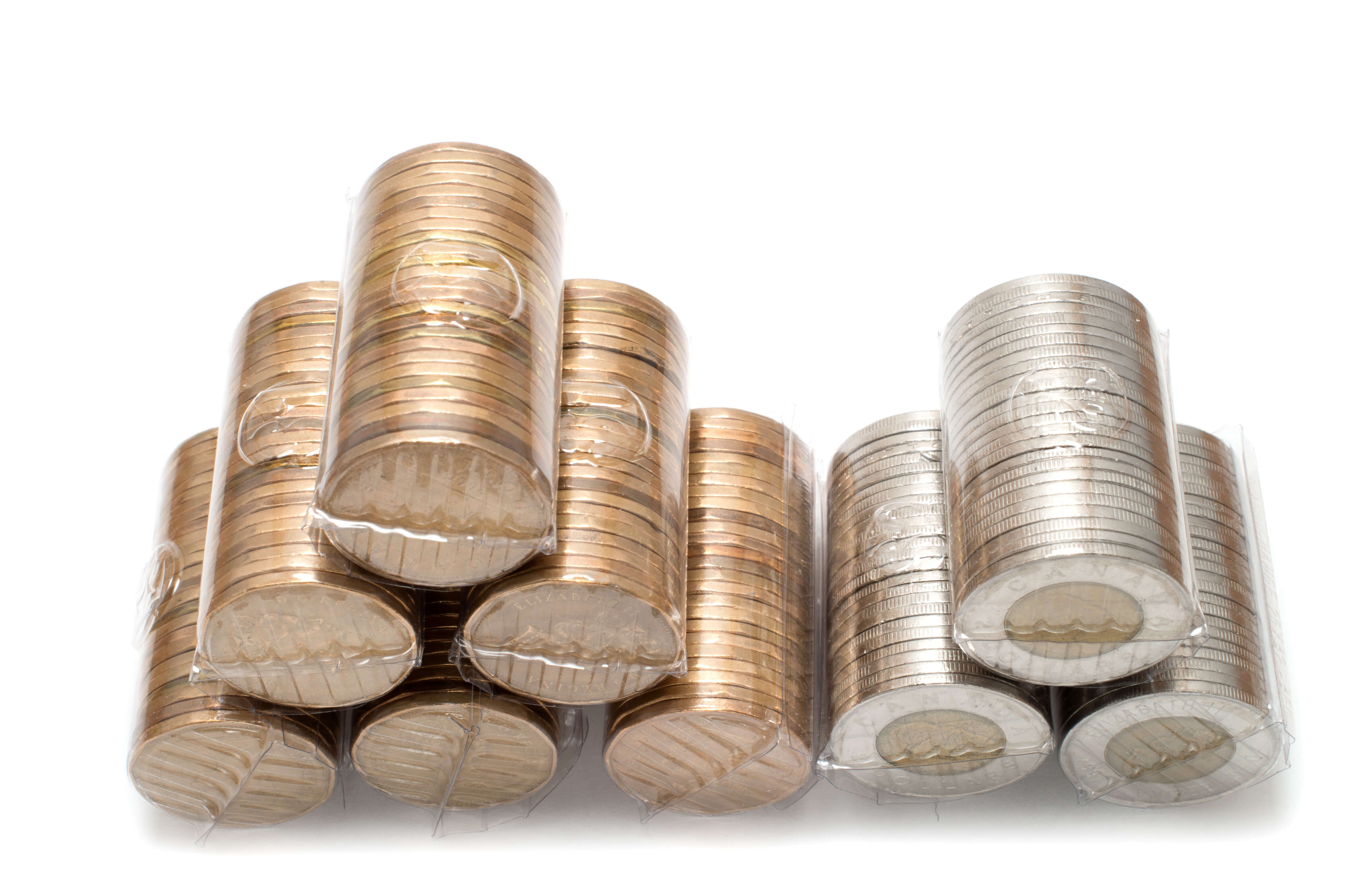
Image via Shutterstock
Canadian currency does not have a one-cent or half-dollar coin. They do, however, have one dollar and two dollar coins—the famous Loonie and the Toonie. Loonie coin wrappers are black, while toonie coin wrappers are purple. Like modern US dollar coin wrappers, both hold 25 coins.
Coin Rolls In The European Union
The European Union includes 19 countries that use the euro as their official currency. To combat waste, the EU uses color-coded hard plastic coin rolls (sometimes called coin cartridges). These plastic rolls have snap closures and are embossed with the denomination and value of the roll.
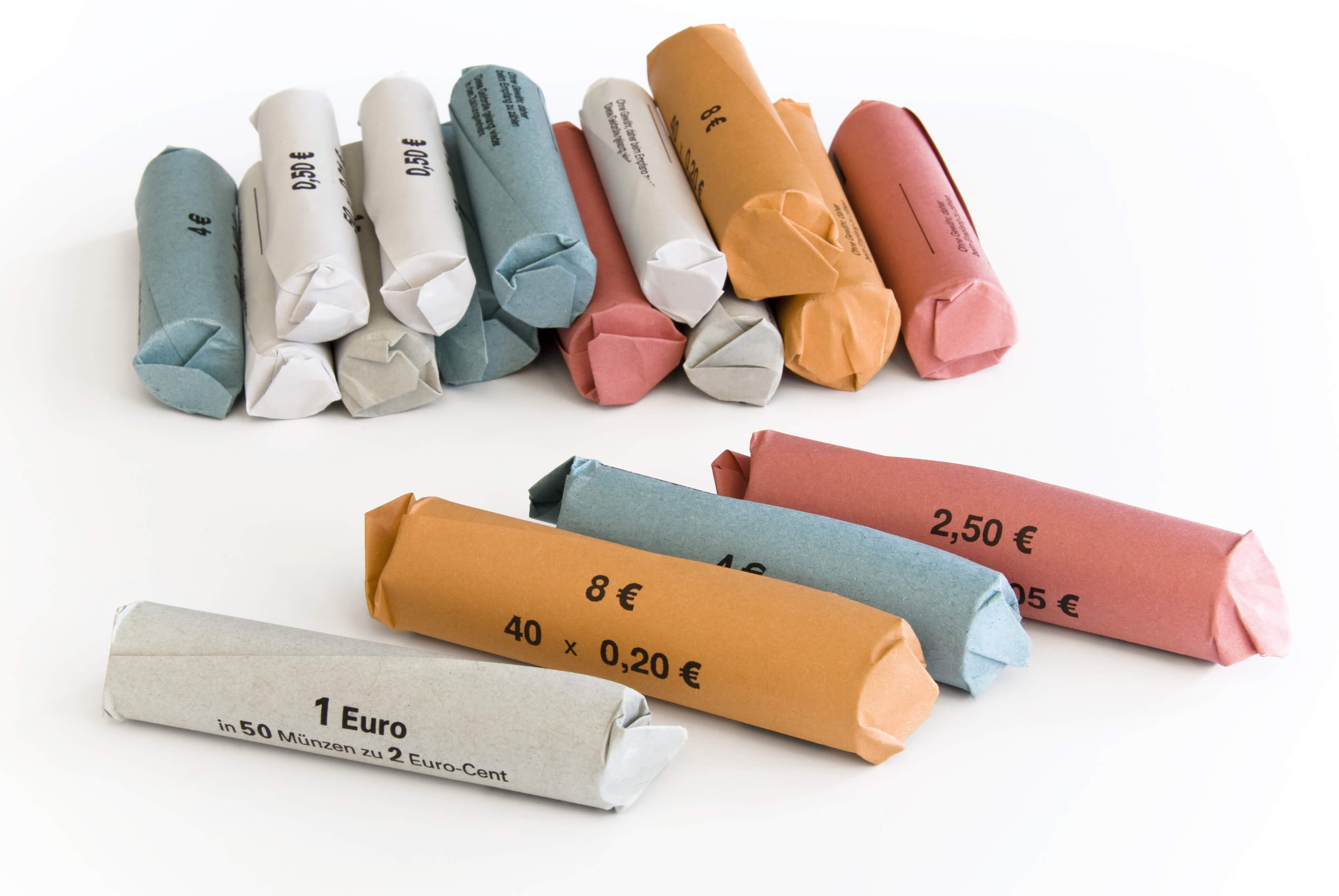
Euro coins in old style coin wrappers.
The Eurozone banking system is moving away from colored coin packs in favor of clear ones, sometimes made with a colored strip.
Some EU countries have abandoned minting the one-cent and two-cent coins as impractical. Like the US, it costs more than their face value to make them. Belgium, the Netherlands, Italy, Ireland, and Finland have all stopped minting the minor coins. Merchants in these countries still have to accept them since other EU nations still produce them.
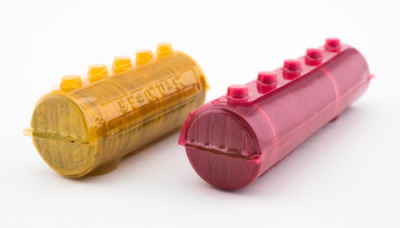
Colored rolls of euro coins.
Coin Rolls of the Euro
*The one-cent and two-cent coins are no longer produced in the EU.
Coin Rolls In The United Kingdom
The UK banking system doesn’t use coin rolls at all. Clear plastic bags with places to mark the denominations are used instead. The bags are supposed to hold a standard number of coins, depending on the denomination. Only one denomination is allowed per bag.
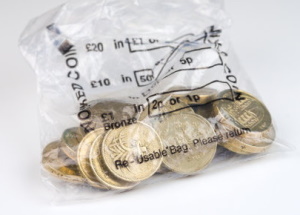
A bag of British pound coins.
British coins are “counted” by weight instead of by the coin. Adherence to this standard has meant that the Royal Mint has to redesign coins to be thicker when it switches to a less expensive, lighter weight material, in order to keep the coins the same weight.
Coin Bags Of The Pound
| One Penny | 100 | £1 | Same weight as 2p bag |
| Two Pence | 50 | £1 | Same weight as 1p bag |
| Five Pence | 100 | £5 | Same weight as 10p bag |
| Ten Pence | 50 | £5 | Same weight as 5p bag |
| Twenty Pence | 50 | £10 | Used to be green bag |
| Fifty Pence | 20 | £10 | Used to be yellow bag |
| One Pound | 25 | £25 | Used to be red bag |
| Two Pounds | 10 | £20 | Always been clear bag |
Technically, you could mix 1 pence and 2 pence coins and get the correct total face value. The same applies to the 5 pence and 10 pence coins. This is highly discouraged these days.
Why Understanding Coin Rolls Matters
Knowing the color of the wrappers allows people to see at a glance what denomination their rolls of coins are. This is especially useful for cashiers and retailers, as they don’t have to stop and peer at the end of the roll to see what coins are inside.
Coin wrapper colors and the amount of coins in each type of coin roll differs between countries (the EU being the big exception due to the European Monetary Union). All that “counts” is that there is a recognized standard for coin rolls of a country.
Read more information about coins and currency on the Gainesville Coins blog:
Coin Collecting for Kids: A Beginner's Guide
Guide to Numismatics: Discover the Thrill of Coin Collecting
Top 15 Best Coins to Collect: A Definitive List
Maya Angelou Quarter Launches American Women Coin Program
Most Asked Questions About U.S. Mint Coins: Buyer's Guide

Steven Cochran
A published writer, Steven's coverage of precious metals goes beyond the daily news to explain how ancillary factors affect the market.
Steven specializes in market analysis with an emphasis on stocks, corporate bonds, and government debt.
